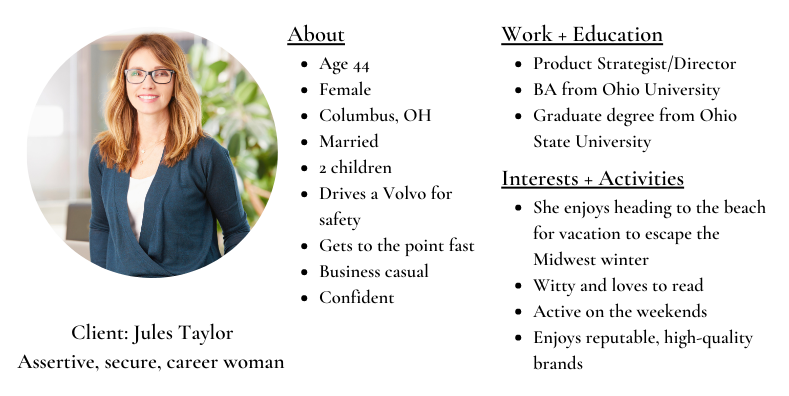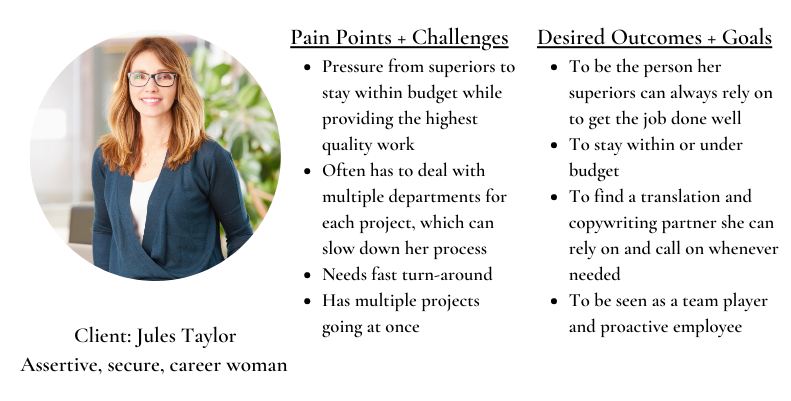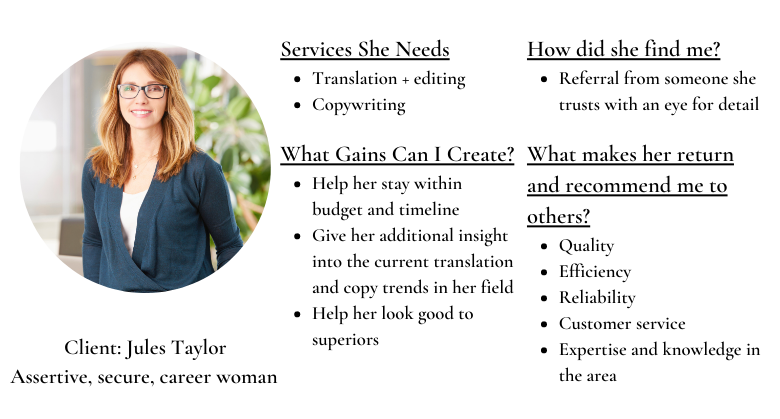How to Create an Ideal T&I Client Profile to Market Your Services
Attracting the “right” clients for you is one of the best reasons to hone your online presence. And yet, when I talk to groups of translators and interpreters during presentations I’ve given or in the courses I teach, many tell me they feel stuck because they haven’t found their ideal client yet. They don’t know who they’d effectively market their services to.
This is not uncommon!
Put in the simplest of terms, an ideal client is someone you enjoy working with and who enjoys working with you. It’s a two-way street of respect, trust, and reliability. Ideal clients pay the rates you ask to be paid without question. They communicate their needs well. They offer you interesting work, and a good volume of it if you’re lucky. Ideal clients respect your boundaries and don’t expect you to work late or on the weekends to finish their projects. They know that you are a professional, and they trust you with their projects. And they pay on time!
You may prefer additional characteristics in a client, but these tend to be the main ones most people think about when determining who they most enjoy working with and whose work and business they appreciate most.
Your ideal client will be different from mine and from the next translator’s or interpreter’s. It’s important, whenever possible, to determine who your ideal client (or clients, plural) is because this will steer your marketing efforts to attract more clients like them. And just as you feel they are ideal for you as a client, they find you to be the right fit for them.
Stay tuned to the end of this post, because I'm going to share an example of a solid ideal client profile that works!
A simple but important mindset shift
One challenge for many freelancers, not just translators and interpreters, simply comes with the nature of freelancing. We reach out to potential clients, or a potential client reaches out to us. And sometimes we know very little about them. As freelancers, we need work in order to pay ourselves regularly, so we accept jobs to fulfill this need. We work on and deliver projects, and in the process, we figure out whether or not we like working with our clients.
But because we have bills to pay, we don’t always think a whole lot about the types of clients we want to work with, sometimes for quite a while depending on how busy we are with the flow of projects we receive. This can become a slippery slope because we can easily end up with a portfolio of clients who don’t pay well, who don’t respect our boundaries, or who treat us like a commodity.
On the other hand, many of us can easily pinpoint an ideal client from our portfolio of clients. Even if you only have one ideal client among all those you’ve worked with before, this is really all you need to start thinking about your marketing efforts and to motivate you to attract more of the “right” (ideal) clients.
Create an ideal client profile
The first step in planning your marketing efforts, whether for your website, or any other way or place you’ll share your services with others, is to create an ideal client profile. This is also often called an ideal client avatar. This profile is a snapshot of what you know about your client, what’s important to them, what their challenges are, and why you’re the best fit for them. You’ll give your ideal client a name (yes, really!), and once your profile is complete and you start to prepare any kind of marketing collateral (your website, online profiles, social media content, blog content, and even print materials), you will rely on this profile to help you speak directly to this type of client. You’ll imagine you’re talking directly to them, having a conversation. You like this person, so you don’t want to come across as stiff or overly bold, right? Instead, you want to be friendly, approachable, knowledgeable, professional, and trustworthy.
So, how do you create an ideal client profile? It’s easier than you think, but so many people resist taking this step in their business, which is a grave mistake. If you don’t know who your ideal client is and how you’re going to appeal to them, you’ll be spinning your wheels, attracting clients from who are not the right fit for you or you for them. Here’s how I create an ideal client profile. You can add details if you wish or leave out a few items, but it’s important to make this profile as complete as possible. And keep in mind that your ideal client may change over time. Mine have! And that’s okay. It simply means you and your business are evolving.
Components of a solid ideal client profile
First, give your ideal client a name and find an image of this person. You can use a headshot of one of your favorite clients if one is publicly available online since this profile is just for you and will not be shared, or you can find an image of a person who depicts your ideal client. These are easily found for free download on stock photo sites. This way, you have an image of your ideal client in mind whenever you create anything related to marketing your business. You will remember that this is the person you are talking to and trying to work with.
Go a little further and assign this ideal client some characteristics. You can be as detailed as you like. Of course, the more details you have about your ideal client, the better. Don’t be concerned right now with why these characteristics are important or how they will serve your marketing efforts. I’ll explain their purpose later in this post. For now, take some time to brainstorm an ideal client by jotting down anything you know about them. If you’re not sure about some of these items, or if you haven’t yet figured out who your ideal client is, it’s okay to make an estimated guess. You can always adjust the profile later.
Some key details to include in your ideal client profile are:
A name (real or fictitious)
A job position or title
Where they work
An approximate age
Gender
Level of education/training
An approximate salary
Where they live
Whether they have a family
What personality traits best describe them
What they like to do outside of work
What brands they might be attracted to
What hobbies they might have
If you think any of this information is unnecessary or unimportant, bear with me. The more you know about your ideal client, the easier it will be to appeal to them!
Once you have started your ideal client profile with some initial information, you’ll want to determine how and why you are the ideal professional for them.
What are their goals at home and at work? What do they aspire to do in their career?
What are their pain points/challenges?
What goals/outcomes do they want?
What services do you offer that can help relieve their pains/challenges?
What services do you offer that help them reach their goals/desired outcomes?
What gains can you create for your ideal client?
How did they find you?
What makes them engage with you?
What makes them want to continue working with you long-term?
What makes them recommend you to someone else?
Summarize this information about your ideal client as best you can, even if you have to guess about a few items for now. Trust that in the end, you will have an ideal client profile that will inform all of your marketing decisions and efforts. You need to feel like you know this person well before you can market to them, and once you do, all of your marketing efforts should be geared toward appealing to this type of client.
Whether you want to create new copy for your website, draft a blog post or article, send an email, craft a social media caption, or prepare content for a more robust marketing campaign, you can rely on your ideal client profile to inform your choice of words, visuals, format, and overall delivery.
When I teach translators and interpreters how to create an ideal client profile, I sometimes sense resistance. Many freelancers don’t see the value of taking the time to create one, mostly because they’ve never thought about doing so or they feel they are infringing on their clients’ privacy in some way. Remember that the ideal client profile is something that only you should have access to, and you don’t have to break any privacy laws or overstep boundaries to gather the information. Just think about what you know about your favorite clients and be as detailed as you can. Every company, big or small, that has a marketing strategy knows who their ideal client is and has created some kind of profile or avatar to inform the marketing strategies they employ.
I can attest that student after student in my T&I Website Blueprint Course has found this exercise to be one of the most valuable steps in creating a website that attracts the right clients for them.
Yes, it can feel a bit tedious at first, but it is necessary. Make it fun!
You’re simply putting down on paper what you know about your clients so you can appeal to them so they can form their own conclusion that you are the right professional for them.
After my students create their ideal client profiles, every one of them says how valuable they found the process to be. Not only did they realize that they knew more about their ideal clients than they originally thought, but this process gave them more confidence to market effectively to those they want to serve moving forward. Win-win!
Example of an ideal client profile
It can be hard to get started when creating your very first client profile. Here's an example you can follow. I've even thrown in some details from one of my own ideal translation client profiles!
I hope my example gives you some idea and that as you create your own ideal client profile, you find the same excitement that I found along the way. Just as we need to know who the audience is for one of our own professional assignments, we have to know who we're talking to when it comes to marketing our businesses.
And the more you know, the easier and more fun it becomes!
Have you ever created an ideal client profile? What did this process teach you, and how has it helped inform your marketing?







